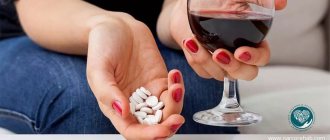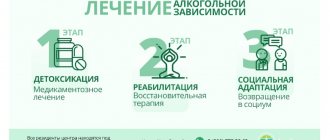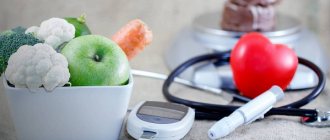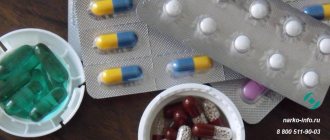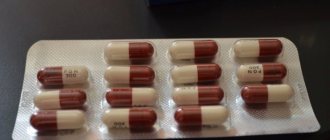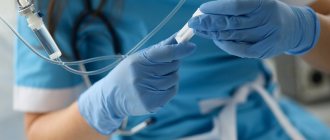Atropine (anatropine) - what is it? Atropine is an m-anticholinergic blocker (pharmacological group), a dangerous plant alkaloid and tropine ester. The medicine atropine looks like a white powder without a distinct odor, quickly dissolves in liquids, including alcohol and water. This substance is a poison for the human body; it is naturally found in nightshades: belladonna (belladonna), datura, henbane . Atropine sulfate formula: C17H23NO3.
Atropine - indications for use
The drug is available both as a solution for intravenous administration (atropine sulfate) and in tablet form; in addition, there are also eye drops.
What is atropine used for medical purposes? Previously, it was used to treat psychosis using atropine coma; today this technique is not used in medicine. Medicines containing atropine (anticholinergics) are used for the treatment of asthma, gastrointestinal tract in gastroenterology, as well as in ophthalmology, psychiatry, pulmonology, cardiology, premedication in surgery, urology, toxicology, poisoning with organophosphorus compounds, etc. However, the drug has quite a lot of contraindications and side effects, it should not be used by those who are allergic to atropine (Atropinum Sulfuricum D5), as well as by glaucoma, liver disease, heart disease (arrhythmia, tachycardia), increased intraocular pressure, etc.
Today, a medicine called atropine and atropine-containing drugs are quite often used by drug addicts for recreational purposes not related to medical indications, to obtain a “high” and a euphoric effect. In the article you will learn everything about atropine, its action and the consequences of non-medical use.
Degrees of severity of psychomotor agitation
In medicine, psychomotor agitation is divided into three degrees of severity.
- Mild degree. Patients in this case only look unusually animated.
- The average degree is expressed in manifestations of lack of purpose in their speech and actions. Actions become unexpected, pronounced affective disorders appear (gaiety, anger, melancholy, malice, etc.).
- A sharp degree of excitement is manifested by extreme chaotic speech and movements, as well as clouding of consciousness.
By the way, how this excitement manifests itself depends to a large extent on the age of the patient. Thus, in childhood or old age it is accompanied by monotonous speech or motor acts.
In children, this is monotonous crying, screaming, laughing or repeating the same questions, rocking, grimacing or smacking is possible. And in elderly patients, excitement manifests itself as fussiness, with an air of businesslike concern and complacent talkativeness. But in such situations, manifestations of irritability or anxiety, accompanied by grumpiness, are also common.
How does atropine affect the human body?
The side effects of atropine are quite extensive, ranging from dizziness to hallucinations. Among the consequences of consuming atropine, one can identify worsening diseases of the cardiovascular system, inflammatory processes on the mucous membrane of the eyeballs (eye drops), rapid heartbeat, and lack of oxygen to the brain. If the drug is beneficial in therapeutic doses, then if used inappropriately it can lead not only to severe intoxication of the body, but also to death.
The effect of atropine on the body:
- stimulation of the central nervous system;
- hallucinations;
- psychosis;
- psychomotor agitation;
- pupil dilation;
- blockage of secretory glands;
- stomach contractions decrease;
- heartbeats increase.
After taking atropine orally, the effects occur within 30 minutes, and when administered intravenously, within a few seconds.
Providing assistance in immobilizing the patient
Psychomotor agitation, the symptoms of which were discussed above, often requires the use of restraint measures. This usually requires the help of 3-4 people. They approach from behind and from the sides, hold the patient's arms pressed to the chest and sharply pick him up under the knees, thus placing him on a bed or couch, previously moved away from the wall so that it can be approached from 2 sides.
If the patient resists by waving an object, then assistants are recommended to hold blankets, pillows or mattresses in front of them. One of them should throw a blanket over the patient's face, this will help put him on the bed. Sometimes you have to hold your head, for which you throw a towel (preferably damp) over your forehead and pull it to the bed by the ends.
It is important to be careful when holding it to avoid causing damage.
Narcotic effect of atropine
The body's response varies greatly depending on the dose consumed. When using a small dose of the substance, a surge of strength and energy occurs, and mood improves. Taking an average dose leads to stress relief and relaxation; an overdose of the drug is fraught not only with poisoning and hallucinations, but also with death. The narcotic effect of atropine is explained by the accumulation of acetylcholine in the synoptic cleft, inhibition of parasympathetic effects and the functioning of the nervous system.
If the permissible daily dosage is exceeded, a person feels warm and relaxed, relaxed, euphoric and slightly dizzy. The narcotic effect of atropine can be compared to the use of marijuana and other cannabinoids containing THC. How a drug affects a person depends on his mood and state of mind before use. If the mood is negative, the substance will only intensify the reaction, which can lead to panic attacks and depression.
Euphoria after a few hours is replaced by the opposite effect: drowsiness, lethargy, weakness, emptiness, weakness. A person has problems with the gastrointestinal tract and a headache. The higher the dose of atropine, the stronger the symptoms of intoxication, the person begins to behave inappropriately, and psychosis occurs due to the effect of the drug on the central nervous system. They are accompanied by mydriasis, insomnia, tachycardia, pressure surges, and behavioral and mental abnormalities. This condition can last about 24 hours.
Clinical picture
Symptoms of psychomotor agitation depend on the causes of the disorder. External manifestations include the following:
- a sharp exacerbation of the main disease;
- inappropriate human behavior;
- increased irritability;
- body movements that are not typical for humans;
- emergence of suicidal tendencies;
- aggressive behavior;
- lack of control over one's behavior.
It is important to consider that patients in this condition pose a serious danger to others. That is why it is so important to promptly treat this pathology. Sometimes psychomotor agitation even leads to suicide.
The emergence of addiction and its treatment
In pursuit of new unusual sensations and euphoria, as well as an attempt to get away from problems, people turn their attention to pharmaceutical drugs. This is exactly the effect that atropine gives: fogginess of consciousness, withdrawal from reality, artificial elevation of mood. Not all people know about the dangers of atropine and the consequences of its regular and excessive use. Even a person who has been prescribed a drug by doctors can become addicted to the drug. Having felt the effect of the drug, a person may become psychologically dependent on its effect.
If a drug helps an addict cope with depression, stress, internal problems and complexes, he will use it again and again, which will lead to addiction. However, no chemical substance can be used for a long time without consequences for the body. The longer the period of use, the more the addict degrades both physically and mentally. As a result of acquiring drug addiction, people only have more problems, they grow like a snowball and do not allow a person to get out of the vicious circle. Only doctors at the Favorit drug treatment clinic in Rostov-on-Don can save a person from imminent death.
The development of addiction is also influenced by the fact that a person stops receiving pleasure in the usual way: from delicious food, walks with friends, a favorite activity, communication with loved ones. The only source of pleasure, euphoria and pleasure is atropine. Soon the addict begins to realize that the usual dose no longer gives the desired effect, so he gradually increases the dosage and also begins to use other pharmaceutical drugs or psychotropic substances. step by step a person loses himself as an individual and becomes one step closer to death.
Causes of compulsive obsessive disorder
The occurrence of pathology is observed under the influence of various provoking factors. The pathological process is diagnosed in people with a genetic predisposition. At risk are suspicious people who tend to doubt and constantly double-check incoming information.
If a child was brought up within strict boundaries and his parents often forbade him to do something, then this leads to obsessive compulsive disorder. When stressful situations arise against the background of fear, the development of pathology is diagnosed. The disease appears in people who often experience nervous strain.
Phases of poisoning
Regardless of whether a person took a large dose of the drug accidentally or intentionally, he will invariably experience severe intoxication. Atropine poisoning leads to the appearance of corresponding symptoms within 10-20 minutes after consumption. A person begins to feel dry mouth and eyes, his temperature rises, and skin hyperemia occurs. There are several phases of poisoning.
Psychomotor agitation
Atropine intoxication leads to various kinds of disorders of the central nervous system, including due to dry eyes, a person’s vision decreases and deteriorates, dizziness, muscle hypertonicity, tendon reflexes, confusion, increased sensitivity to light, mydriasis, convulsions, psychosis occur. . A person addicted to a psychoactive substance begins to behave inappropriately: laugh, cry, perform strange actions, run. He may experience visual, tactile or auditory hallucinations, and mental disorders with predominant psychomotor agitation occur.
CNS depression
Disruption of the nervous system begins in a person within 7-10 hours from the moment of consuming atropine in an increased dosage. The victim feels weakness or twitching in the muscles, his thoughts are confused, he cannot formulate a sentence. The danger of the drug is that its excessive use can lead to coma.
When taking a large dose of the drug, the symptoms of depression of the nervous system are very obvious, and there may not even be psychomotor agitation. Feeling the desire to sleep, a person falls asleep, but the drug causes disruption of the heart, blood vessels and respiratory system, which can cause death in sleep. Asphyxia, respiratory arrest, heart failure, and pulmonary or cerebral edema may occur due to breathing problems.
Several more types of psychomotor agitation
In addition to those listed above, there are several other types of psychomotor agitation that can develop in both a healthy person and someone with organic brain damage.
- Thus, epileptic agitation is characteristic of the twilight state of consciousness in patients with epilepsy. It is accompanied by an angry-aggressive affect, complete disorientation, and the impossibility of contact. Its beginning and end, as a rule, are sudden, and the condition can reach a high degree of danger for others, since the patient can attack them and cause severe damage, as well as destroy everything that he encounters along the way.
- Psychogenic psychomotor agitation occurs immediately after acute stressful situations (disaster, wreck, etc.). It is expressed by varying degrees of motor restlessness. This can be monotonous excitement with inarticulate sounds, or chaotic excitement with panic, flight, self-mutilation, and attempted suicide. Often excitement gives way to stupor. By the way, during mass disasters, a similar state can affect large groups of people, becoming common.
- Psychopathic arousal is superficially similar to psychogenic, since it also occurs under the influence of external factors, but the strength of the response in this case, as a rule, does not correspond to the cause that caused it. This condition is associated with the psychopathic characteristics of the patient’s character.
Treatment of intoxication
How to cope with poisoning? How is acute atropine intoxication treated? First of all, you need to call the Favorit RC and call the emergency drug treatment service to your home. Doctors will arrive within 30-40 years. However, quite often victims require pre-medical assistance; you can get detailed advice from professionals by calling our clinic’s hotline absolutely free. The patient will also need emergency medical care and then hospital treatment.
How to remove poison from the body without harming the health of the addicted person? First of all, doctors carry out a detoxification procedure. To cleanse the body of toxins as quickly as possible, droppers with adsorbents and a number of medications are used to speed up metabolism and normalize the patient’s general condition. In addition, depending on the degree of intoxication, the following measures are used: gastric lavage (potassium permanganate), induction of vomiting, use of laxatives and diuretics, hemosorption.
Next comes the turn of symptomatic treatment and elimination of physiological disorders in the addict’s health. The drugs are used according to indications and contraindications. In case of severe clinical picture and breathing problems, tracheal intubation and artificial ventilation are used, resuscitation measures include installation of a catheter and administration of the necessary medications intravenously.
In case of atropine poisoning, the victim must be given an antidote: Physiostigmine, Aminostigmine, Nivalin or Galantamine in an individual dosage. These drugs help to quickly get rid of the unpleasant consequences of intoxication and symptoms such as hallucinations.
Use by drug addicts
Recreational use of atropine has recently begun to increase.
Today it is quite easy to find a prescription or an illegal drug on the Internet and social networks. Pharmacy drugs are among the cheapest and most accessible, despite the ban and criminal prosecution for distribution without a doctor's prescription. Most often, people who are addicted to atropine are those who have already used or are using narcotic substances. Drug addicts can combine the drug with alcohol, other pharmaceutical drugs, tranquilizers, psychostimulants, opiates, etc. The use of several chemical substances in order to obtain a euphoric effect is called polydrug addiction.
Dual addiction is quite difficult to cure. It is worth noting that it is impossible to get rid of this kind of drug addiction on your own at home. It is necessary to contact a specialized drug treatment clinic. Our rehabilitation center in Rostov-on-Don provides assistance to all drug addicts and their loved ones, regardless of their length of use.
Systematic, regular use of atropine in high dosages leads to serious health consequences for addicts. This is not only a disruption of the central nervous system and depression of cognitive functions, and, accordingly, a person’s intellectual abilities, but also the development of heart and vascular diseases, and disruption of the respiratory system. The addict has problems with communication and socialization. Physical and mental dependence lead to the emergence and development of severe withdrawal symptoms.
Nervous overexcitement
Increased nervous excitement, as a rule, indicates a weakening of inhibitory nervous processes. According to the law of similarity, which forms the basis of homeopathic treatment, the potentized homeopathic preparation of caffeine Coffea cruda may be useful for an excited patient if the excitement is such that the limbs tremble, the person cannot cope with the influx of thoughts, nervous heartbeat and even a joyful mood, and sleep does not occur.
When the mental excitement is expressed by talkativeness, and the patient (usually a woman) appears lively and cheerful, but in reality it is a morbid condition, Lachesis and Cimicifuga are indicated.
Palladium and Sepia women are excited in company, but almost decompensated at home.
Excessive antasia - Belladonna, Cannabis indica, Hyosciamus, achesis. Stramonium.
A good remedy for painful excitation is potentized Camphor. Rhus has an unbalanced mood (internal restlessness, need for constant movement, as in the case of Chamomilla).
The drugs of choice for mental overexcitation are Aconitum, Anacardium, Argentum nitricum, Aurum, Causticum, Kalium bromatum, Opium, Moschus.
In severe cases of neurosis, obsessive ideas and sensations are formed (fear of space, animals, transport, public and performances, fear of illness, fear of imminent death).
With neurosis, in contrast to delirium, a critical attitude towards one’s condition is usually retained, and obsessive drives (for example, the desire to jump from a height) are usually not realized.
The leading remedy for a patient with truly obsessive ideas is Thuja: sometimes the patient believes that animals are moving in the stomach, sometimes the limbs are made of glass and will break. The patient constantly thinks about this and cannot get rid of these ideas, despite their absurdity.
The Argentum nitricum patient has an obsession with tall buildings falling on him in the street. If the patient feels as if his body and mind are separate, Anacardium or Tuja may help. An additional symptom for Anacardium is an obsessive feeling that the mind is being controlled by some superpower.
The Aurum metallicum patient is gloomy, constantly thinks about death and the extinction of life, and is depressed by a feeling of complete insignificance. Obsessions of a sexual nature are characteristic of Staphysagria (in contrast, in Sepia even the thought of sex makes her angry). The Silicea patient is consumed by an increased sense of responsibility, as well as a strange, persistent desire to sit on the floor and count small objects.
Mechanism of action of atropine
The drug blocks M-receptors and nerve impulses. Atropine binds to areas of the brain instead of acetylcholine, as a result of which various abnormalities occur in the human body, including inhibition of impulses from the central nervous system and suppression of the secretion of sweat, salivary and a number of other glands. As a result, the smooth muscles of the intestines, gastrointestinal tract and bladder relax and expand. Atropine causes paralysis of accommodation and mydriasis, farsightedness, increased heart rate, bradycardia, and vasodilation.
Overdose and poisoning
Atropine, depending on the form of release, can be used orally, intravenously, in the form of eye drops, intramuscularly and subcutaneously. The therapeutic dose of the drug when taken orally is 0.25-1 mg (no more than 3 times a day). The dosage depends on the individual characteristics of the human body. For intravenous and intramuscular administration, the dose is identical. If your doctor has prescribed you drops to dilate the pupil, you should not take them in excess of the prescribed dose, a maximum of 2 drops 2 times a day. Even if a person does not intend to obtain a narcotic effect, if the dose is exceeded, an overdose can occur. In addition, atropine is found in the fruits of plants from the nightshade family, which can also easily be poisoned.
Symptoms of atropine overdose
- dilated pupils;
- lack of reaction to light;
- nausea, vomiting;
- tremor of the limbs;
- thirst, dry mouth;
- difficulty urinating;
- headache;
- dizziness;
- rapid pulse;
- accelerated heartbeat;
- high blood pressure;
- cramps, spasms;
- constipation.
Atropine overdose can occur not only when the dose is increased, but also when combined with other chemicals and toxins, including alcohol. As soon as you notice the first signs of intoxication and poisoning, you should call the Favorit RC in Rostov-on-Don. Doctors at our center have the opportunity to come to the patient’s home and carry out all the necessary resuscitation measures, as well as pre-consult relatives about emergency care.
Within 30-40 minutes, the toxic effect of atropine occurs, which can last for several days. Toxins spread throughout the body, poisoning it and accumulating in the tissues of internal organs. A pharmaceutical drug can linger in the body of an addicted person for quite a long time. This is why a person becomes lethargic, weakened, painful, irritable, and loses interest in others. The drug removes all useful substances and vitamins from the body, reducing the addict’s immunity. A person begins to have problems with teeth, hair, nails, and skin.
There are 3 degrees of atropine poisoning: mild, moderate and severe. If at the first stage a person can still cope with the symptoms on his own at home, then in the case of moderate poisoning it is worth calling an ambulance at home. If you do not contact the clinic in time, atropine will begin its harmful effects and destructive effects on the human heart, liver, kidneys, blood vessels and central nervous system. Frequent symptoms of atropine intoxication: hallucinations, psychosis, loss of coordination, abnormalities of the nervous system.
If an addict regularly uses atropine to obtain a euphoric effect, the consequences of taking it can be much sadder and more dangerous: paralysis of the respiratory muscles, coma, death. While in a coma, a person is at risk of impaired cognitive functions and intellectual abilities, and mental abnormalities. It is not difficult to calculate the lethal dose of atropine; it is 1.5 mg per 1 kg of body weight of an adult. Death from abuse and overdose occurs within 5 hours after use.
Treatment of atropine addiction in Rostov-on-Don
Treatment of atropine addiction, as well as addiction to any pharmaceutical drugs, takes place in a drug rehabilitation center in Rostov-on-Don. Therapy includes detoxification and symptomatic treatment, as well as rehabilitation, which stabilizes the addict’s condition and consolidates the treatment results. Doctors help patients eliminate psychological cravings for psychoactive substances through group and individual sessions. During the treatment process, various psychotherapeutic and medicinal techniques are used, as well as psychocorrection and family therapy, especially necessary for adolescents. The last step in the treatment of drug addiction is resocialization and adaptation to society.

